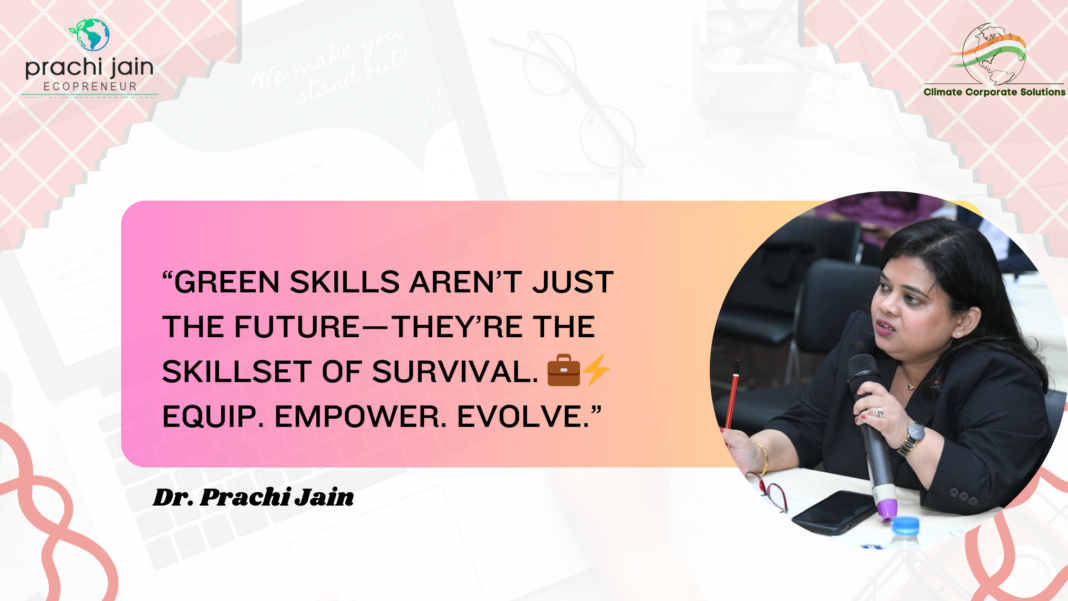Dear Readers!
Have you ever wondered whether we are embracing sustainability in every spectrum of life and, in doing so, are we equipping ourselves with the skills needed to secure a sustainable future for our planet and its people?
As the world grapples with the urgent challenges of climate change, biodiversity loss, and resource depletion, one question emerges: how can we prepare for a sustainable future? The answer lies in fostering green skills, i.e., the knowledge and competencies that enable individuals and organizations to drive sustainable development. These skills are more than technical know-how and represent a transformative force reshaping industries, economies, and societies.
Green skills are already proving their value. According to the International Labour Organization (ILO), transitioning to a green economy could create 24 million new jobs globally by 2030. However, a 2021 PwC report highlighted that 50% of CEOs see a lack of green skills as a significant barrier to implementing sustainability strategies. This gap reveals the urgency of scaling up green skills to meet the demands of a rapidly changing world.
Just as when we realize that Green Skills are essential, a million-dollar question remains: What Are Green Skills, and Why Are They Essential?
Green skills encompass various abilities, from expertise in renewable energy and sustainable agriculture to eco-friendly urban planning and waste management. They empower individuals to develop solutions that mitigate environmental harm, enhance resource efficiency, and promote economic resilience. As the global economy increasingly depends on sustainable practices, these skills are no longer optional but essential.
The available data show a sizeable connection between green skills and economics. The World Economic Forum (WEF) estimates that $44 trillion of global GDP, more than half the world’s economy, depends on nature and its services. Industries can reduce their environmental footprint by equipping workers with green skills while capitalizing on emerging opportunities in sustainability-driven markets.
Friends, we have been discussing these green skills, but what is even more essential is understanding how to transform industries with green skills.
Across sectors, green skills drive innovation and redefine what it means to operate sustainably. In renewable energy, for instance, roles like solar panel installers and wind turbine technicians are in high demand. India’s National Solar Mission, which aims to generate 280 GW of solar power by 2030, is projected to create 1.6 million jobs, supported by initiatives like the Solar Energy Training Network (SETNET).
Additionally, agriculture is also undergoing a green revolution. Farmers trained in sustainable practices such as crop rotation, organic farming, and water conservation are improving yields while preserving ecosystems. Programs like Zero Budget Natural Farming (ZBNF) in India have reduced costs and enhanced soil health and biodiversity, proving that sustainable practices can lead to economic gains.
Another critical sector is Urban planning and construction, which are similarly transforming, with green architects and planners designing eco-friendly cities. Singapore’s Green Mark Certification has led to over 3,500 green buildings, showcasing how skilled professionals are reshaping urban landscapes for sustainability.
Meanwhile, the circular economy is thriving thanks to workers skilled in recycling, repair, and sustainable product design, as seen in the European Union’s Circular Economy Action Plan, which has created jobs while reducing waste.
What is even more attractive to investigate is that if Green Skills are critical in developing a sustainable world, how do we build a Workforce for a Green Economy?
Education and training systems must adapt for green skills to become a cornerstone of the global economy. Traditional curricula must integrate sustainability concepts, and vocational training must prepare workers for emerging roles in green industries. A vital example is that Germany’s dual-education system offers a compelling model, combining theoretical learning with practical training in renewable energy and sustainable manufacturing.
In addition, Upskilling and reskilling are equally important. Existing workers need opportunities to transition into green roles as industries evolve. For example, the US “Building a Better Grid” initiative includes workforce development programs that train individuals to build and maintain clean energy infrastructure, bridging the gap between industry needs and workforce capabilities.
With all the innovative ideas, public-private partnerships are equally vital. The Green Jobs Initiative, a collaboration between the ILO, UNEP, and ITUC, supports training programs that empower workers while fostering environmental stewardship. These collaborations ensure that green skills development is inclusive, well-funded, and tailored to local needs.
Like any new and innovative initiative, embracing and providing training for green skills is not devoid of challenges, and overcoming these challenges by adopting green skills development becomes daunting.
Lack of awareness, funding constraints, and gaps between workforce capabilities and industry demands are significant hurdles. Additional concerns include measuring the impact of green skill initiatives and ensuring inclusivity in training programs.
Therefore, addressing these barriers requires coordinated efforts by all the stakeholders involved.Governments can offer tax incentives for businesses investing in green skills development, while international organizations can provide financial and technical support to developing nations. Awareness campaigns showcasing success stories, such as Dow Chemical’s “Valuing Nature” initiative, which has invested $500 million in environmental projects, can inspire broader participation.
So, how do organizations lead the way and ensure that Green Skills become the foundation for embracing sustainability? As industries evolve and global priorities shift, green skills have never been more critical. They are the bridge between ambition and action, enabling businesses and communities to navigate the complexities of sustainability. From creating millions of jobs to achieving climate goals, green skills are a cornerstone of the green economy.
Nevertheless, the question remains: Are we moving quickly enough to seize this opportunity? The world stands at a crossroads where the decisions we make today will determine the future we leave behind. Green skills are more than a tool—they are a pathway to resilience, prosperity, and a healthier planet.
In conclusion, Green skills are not just a response to the challenges of today; they are the foundation for tomorrow’s opportunities. The question is no longer whether we need them but whether we are ready to prioritize them at the scale required. As businesses, governments, and individuals, the choice is ours: invest in green skills and build a thriving, sustainable future, or risk falling behind in a world demanding change. Afterall, it is upon us to decide and think:
Are we ready to commit to empowering the workforce needed to shape a sustainable tomorrow?
Till we meet again
Dr Prachi Jain



